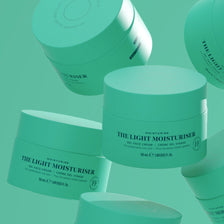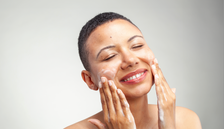By Claire Coleman
The first most beauty fans heard about peptides was in 2006 when, in a subsequently much spoofed Olay TV ad, celebrity beauty editor Nadine Baggott told viewers “Right now, I think the hottest anti-ageing ingredients around are pentapeptides.” Back then most of us didn’t know what a peptide was or what it could do, but in fact, peptides had been floating around in the world of skincare since the 1970s. (If you’re still none the wiser, it’s basically a small protein, composed of two or more amino acids, which are the building blocks of proteins. A pentapeptide is a peptide made up of five amino acids, while a dipeptide is made up of two, and a tripetide from three).
“One of cosmetic science’s best approaches is to look at how the body does things, and bottle it,” says Daniel Isaacs, director of research at Medik8.
And that’s exactly what happened in the early ’70s when someone called Loren Pickart identified and isolated a copper peptide in blood plasma, and discovered that it was present in greater quantities in young people than it was in older people. Mike Bell, who is head of science research at Walgreens Boots Alliance, says that this discovery was “probably the inspiration for peptides in cosmetics,” although its application in skincare didn’t happen until some years later.
“In the 1980s, it started to become apparent that this peptide was important in wound healing,” explains Mike.
Basically, when skin is injured, the proteins in the skin break down into peptides and, at some point, they establish a feedback loop that tells the body: “Hey, there’s damage here that we need to repair.” Part of the way that the body responds to that damage is to produce more collagen – one of the proteins that is involved in helping the skin repair itself, but also the protein that’s responsible for keeping skin looking plump and feeling bouncy and firm. As we get older, the levels of collagen in our skin decrease, and the speed at which we make new collagen decreases too – can you see where this is going?
Ultimately – as is often the case with technologies found in skincare – research that had initially been carried out with a view to medical applications started to be incorporated into skincare.
We’ve really got a company called Sederma to thank for that – but unless you’re a real skincare geek, you’ll never have heard of this ingredient manufacturer who, in 2000, created a synthetic (ie. made in a lab) peptide which they called Matrixyl. This was designed to work like one of the peptides that occur naturally in the body and signal to it to make more collagen. This is quite common in the skincare industry – there are specialist manufacturers who develop ingredients, which they then sell to the beauty brands that you see on the shelves. Sometimes, one beauty brand will buy exclusive rights to use an ingredient, but very often they are widely available to a number of different brands. And so you undoubtedly will have heard of Olay, who was one of the first mainstream companies to incorporate Matrixyl into skincare when they launched Olay Regenerist in 2003 – Matrixyl is the pentapeptide referenced in that infamous advert.
And actually, it’s probably the reason why another of the UK’s most popular face creams was found to be so effective.
In 2007, a Boots No7 serum, Protect & Perfect, hit headlines after a BBC Horizon documentary showed scientists at the University of Manchester proving that the serum could rejuvenate photo-aged skin. Effectively you had a bunch of independent professional scientists (rather than those paid by the skincare companies) saying: “Actually, skincare isn’t just oil, water and snake oil; some of this stuff really works and can even turn back the clock, just like they promised.”
At the time, it was believed that it was the retinyl palmitate – a form of vitamin A which is a much-studied, gold standard anti-ageing ingredient – in the formulation that was responsible for the effects, but Mike Bell admits that, in subsequent tests on the individual ingredients: “We never found that the retinyl palmitate does much at the levels we use it: it’s the peptides driving the changes we saw.”
Perhaps not surprisingly given the success of the original molecule, Sederma went on to create other similar peptides in the Matrixyl family, and the credibility – and validity – of the ingredient was rubber-stamped in 2013 when independent research at the University of Reading found that, used in the right quantities, Matrixyl can almost double levels of collagen in the skin.
And this sort of proof is essential for brands like Medik8.
“The main advances we’ve seen in this area are clinical data to support ingredients, which means brands like us can pick apart those that have genuine effects rather than those that just have a theory,” says Daniel Isaacs. “Our heritage is in vitamin C, vitamin A and sun protection, because there’s a wealth of science behind these three areas. Matrixyl was the first peptide we really invested in because there are published studies behind it with fantastic data.”
But peptides that tell the body to make more collagen are only the start, as Prudvi Kaka, chief scientific officer at Deciem, explains.
“Peptides in skincare currently can be classified into four different categories including: signal peptides, carrier peptides, neurotransmitter inhibitor peptides and enzyme inhibitor peptides.”
Matrixyl falls into the signal peptide category – peptides that tell the body to do something (like make more collagen). Carrier peptides deliver trace elements, which are important for the healthy function of skin, and copper peptides – which you may have heard of – are part of this group. Then there are the neurotransmitter inhibitor peptides – they’re the ones that get called “Botox in a bottle” and one in particular, Argireline, pops up a lot in skincare. The idea is that peptides like this can actually target muscle movements, potentially decreasing the facial muscle contraction, reducing dynamic lines and wrinkles. Finally there are enzyme inhibitor peptides and these work to prevent certain enzymes from breaking down components of the skin that you might want to keep such as collagen, for example.
However, there’s more to it than just finding a peptide that works on paper.
In order to get the proof that Daniel Isaacs was talking about that something works IRL, you have to formulate the product in such a way that means the peptides get to where they need to get to, so that they can do what they need to do.
And that’s not always straightforward, as Frauke Neuser, senior director of scientific communications at P&G, which owns Olay, explains.
“The original pentapeptide doesn’t penetrate skin very well because it is attracted to water, and skin tends to be oily, so to get it to penetrate, a compound that is attracted to oil had to be added.”
And that’s another area where Daniel says there’s been a lot of innovation since the early days.
“Another of the advances that we’ve seen is cool penetration and bioavailability technology that ensures that the peptides can carry out their role.”
But once the scientists have sorted the technical side of things, as a consumer, they’re a bit of a dream ingredient.
“They’re well tolerated,” says Daniel. “They don’t tend to disagree with other ingredients or skin types, so they’re easy to add into your routine and pretty much anyone can benefit from a peptide. If we’re talking about signalling peptides, we know that cellular communication starts to decrease from around your 30s and peptides can counter that, so as you get older, your skin can continue to behave the way that younger skin does naturally.”
And, when it comes to the future, well, for peptides, it looks pretty good.
“The big advantage peptides have over vitamin C or retinoids is that there are thousands of possibilities, both in terms of the amino acids that can be combined to make a single peptide, but also in the way you can combine them and have them work together synergistically. Meaning two together has an effect that’s better than you might expect – and better than both individually,” says Frauke.
Mike Bell agrees that “there’s loads of opportunity” when it comes to peptides.
“With peptides, we’re trying to mimic the natural processes that happen in the body and the skin. And, as we know that different types of peptides play a number of roles in skin, it could be that, in the future, we see peptides that can help with a range of skin conditions, including rosacea, pigmentation, sensitivity and much more.”
And the good news is that, from an environmental point of view, things are only going to get better.
“Peptide manufacturing is becoming more sustainable and avoiding the use of harmful solvents,” says Prudvi Kaka. “Peptide computing is also progressing with custom-sequencing of amino acids, which makes the process of synthesising new peptides easier and faster.”
And that’s the exciting thing about peptides. It feels that while there are some – hey Matrixyl family, looking at you – that we know and understand well, there are huge areas of opportunity for innovation and development. And in the world of skincare, to find a group of ingredients that are both proven, and have genuinely exciting potential that we have yet to uncover, is a rare and wonderful thing.




























